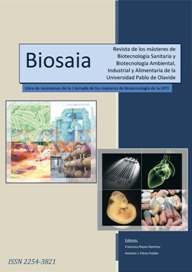Engineering self-regulated synthetic gene expression systems and its application on controlled protein expression
Palabras clave:
Genetic circuits, Synthetic biology, Biotechnology, BiosensorsResumen
One of the limiting factor in industrial biotechnology is the lack of cost-effective and regulated gene expression systems at large-scale. Thus current approaches suffer of suboptimal gene expression levels and/or they require of expensive inducer metabolites. The emergent of synthetic biology including new highthrouput DNA assembly methods and sophisticated biosensors now allow the redesign of complex bacterial trait including automata and full pre-programed gene expression control systems. This high level of control allows save inducers in bioprocesses and/or reducing the time where the cells and toxic intermediates are in contact by generating an auto-regulated expression system.
With the aim to address this important shortcoming in industrial biotechnology and provide a cheap and highly controlled gene expression system at large scale, in this work we firstly have developed a new highthrouput DNA assembly system based on GoldenGate´s MoClo [1] adapted to the Standard European Vector Architecture (pSEVA) [2]. The new methods was further used to generate a large array of complex circuits capable of regulate genetic expression according to phosphate concentration by taking advantage of an existing collection of synthetic promoter available at SBG group [3].
The circuits were generated by assembling synthetic transcriptional units using random assembly of synthetic promoters and ribosome binding sites driving the expression of well-known reporter fluorescent proteins such as GFP and RFP, thus resulting on a wide variety of circuits. The circuits obtained where subsequently analyzed by following the fluorescent profile under different phosphate concentrations media. Those that showed a more promissing behavior where selected to be further studied and sequenced to determine those random elements. Ongoing efforts have focus on the construction of a set of well-characterized synthetic circuits driving the a la carte and self-regulated expression of a given gene, even a whole metabolic pathway.
In summary, we have obtained a way number of different plasmids, circuits and components that can be used to elaborate new circuits and constructions with all new applications and functions such as the above mentioned genetic expression self-regulation based on externals factors like phosphate concentration and its application to large scale production systems.





